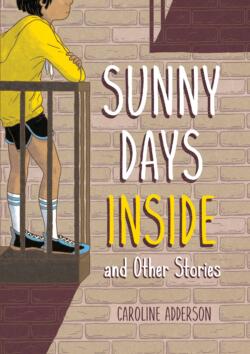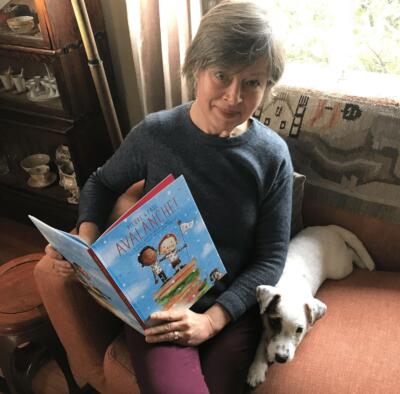1585 Truisms of the quarantine
Sunny Days Inside and Other Stories
by Caroline Adderson
Toronto: House of Anansi (Groundwood) 2021
$16.99 / 9781773065724
Reviewed by Alison Acheson
*
 Caroline Adderson’s work, whether for adults or children, crackles with vibrancy of language, and colour-filled image and tone. Always. Her recent and covid-inspired collection of connected short fiction for middle-grade readers — Sunny Days Inside and Other Stories, is no exception to “crackle.” You hear the voices of lively and real children taking flight from being mere words on page. Real children in a grocery store:
Caroline Adderson’s work, whether for adults or children, crackles with vibrancy of language, and colour-filled image and tone. Always. Her recent and covid-inspired collection of connected short fiction for middle-grade readers — Sunny Days Inside and Other Stories, is no exception to “crackle.” You hear the voices of lively and real children taking flight from being mere words on page. Real children in a grocery store:
Once Alek had dared Ivan to touch a cow’s tongue. The tongue was huge and purple, but Ivan touched it through the plastic wrapping. Then he dared Alek. Just as Alek reached out, Ivan shoved him. Alek’s finger punctured the plastic and came into actual contact with the tongue. It was the worst moment of Alek’s life so far.
As a reader, an adult reader, this made me shudder. And remember — yes, exactly how it is!
For young readers, it’s good to know: the same stuff that happens to me happens to others, too. It’s a big piece of why we read. And so we read on.
The “connected” piece in this collection comes in the form of a block of apartments in which the characters and their stories live. The urban families who dwell here come in twos and fours. And alone. Some are crowded and saving for the dream of home-ownership. As the stories move on, the reader is reacquainted with earlier characters, and we see their growth.

We see too, the truisms of those quarantine times: no haircuts, bread-baking, renting a neighbour’s dog to be able to go for walks, and just getting to know each other in unexpected ways. Banging pots at 7 p.m. Painting rocks for neighbourhood gardens. And all those squirrelled-away rolls and rolls of toilet paper!
Adderson’s details of everyday life — a little brother’s fly collection, food crumbs, howler monkey-sounding garbage truck — are dead on. Humour is the light on the path to finding one’s way. Wonder-filled juxtaposition is another common element in Adderson’s work. So here we have a super-hero with a brassiere; travelling afar while at home; a love story with a description of a mouthful of braces; a study in becoming less shy … while social-distancing.
Adderson is an artist — her questions are bigger than the moment: how does a child live with adult grief — the loss of livelihood? the loss of dreams? And how do children navigate the loss of their own dreams, dreams so significant and must-have when one is young?
Ah, adult reality: “Connor left his father staring down at Mrs. Watts, an ugly, lemon-sucking expression on his face.”
This reality, even as a young person handles it as only a young person can, with honesty and kid-fuelled fairness:
Dad wasn’t like this before — mad all the time. Mostly he was a nice guy. Connor knew he was acting like this because he’d lost his job, because, like the school-board website said, ‘Disruptions in routine can be stressful.’ And no hockey!
Moments like these amidst the humour and the delightful plots, give kids ways to rehearse life, to consider what might be their own reactions; such stories serve to grow their understanding. And that understanding can lead to empathy and compassion.
A good mix of ages live in the apartment block. The collection could be read as a family — if we’re ever again stuck in our homes. Or if we just want to remember what it is to be connected with family and neighbours — known and hitherto unknown — in our spaces.

Who will read these stories in a few years? In a decade? Will the pandemic through-line in these stories, and the covid experience fall away in some hoped-for distant memory — we’d all like it to be distant memory. In answer, I consider the books I read as a child, often about the Great Depression, years of the 1930s, then books about the 1960s and 70s, the years of the Civil Rights movement in the U.S., and other challenging times. Writing about, and setting stories in such times, has a significant place in literature for children — for all, really. These stories give us models, the knowledge that we have gotten through, and we can get through again, and in the case of Sunny Days Inside, we can navigate with humour and grace.
In the closing story, there’s a scene of gratitude for the simplest things in life — the freedom to walk on a street and embrace a mailbox or a stop sign — daily stuff that can be so taken for granted. Until it’s no longer in our lives. The scene stays with the reader, filled with reality and love. There’s another memorable scene, too, to close, but I’ll leave that for you to discover.
And I wonder if there are any vacancies in this apartment building; these are good people to live with.
*

Alison Acheson is the author of almost a dozen books for all ages, with the most recent being a memoir of caregiving: Dance Me to the End: Ten Months and Ten Days With ALS (TouchWood, 2019). She writes a newsletter on Substack, The Unschool for Writers, and lives on the East Side of Vancouver.
*
The British Columbia Review
Publisher and Editor: Richard Mackie
Formerly The Ormsby Review, The British Columbia Review is an on-line journal service for BC writers and readers. The Advisory Board consists of Jean Barman, Wade Davis, Robin Fisher, Barry Gough, Hugh Johnston, Kathy Mezei, Patricia Roy, Maria Tippett, and Graeme Wynn. Provincial Government Patron (since September 2018): Creative BC. Honorary Patron: Yosef Wosk. Scholarly Patron: SFU Graduate Liberal Studies.
“Only connect.” – E.M. Forster
6 comments on “1585 Truisms of the quarantine”